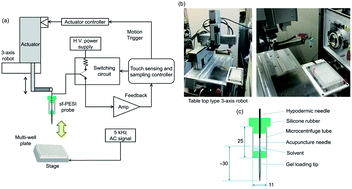Robotic sheath-flow probe electrospray ionization/mass spectrometry (sfPESI/MS): development of a touch sensor for samples in a multiwell plastic plate†
Abstract
In the previous work, sheath-flow probe electrospray ionization (sfPESI) equipped with a touch sensor was developed for conducting samples. In this work, a capacitiance-sensitive touch sensor that can be applicable to samples prepared in a nonconducting plastic multiwell plate was developed. The radiofrequency with 5 kHz and 4.5 Vpp was applied to the metal substrate on which the plastic plate was placed. The probe tip stopped at the position where it touched the surface of the liquid solution prepared in the plastic multiwell plate by detecting the displacement current flowing through the capacitance of the circuit. By coupling a nondisposable sfPESI probe with a table-top 3-axis robot, consecutive analysis of peptides, proteins, drugs, and real samples was performed. The carry-over by the consecutive analyses was suppressed to minimal by cleansing the probe tip using the solvent of water/methanol/acetonitrile (1/1/1).



 Please wait while we load your content...
Please wait while we load your content...